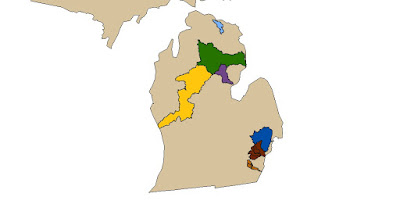I'm Corey Krabbenhoft and I am currently a Ph.D. candidate in Donna Kashian’s lab at Wayne State University in Detroit. I am very excited to be contributing to Michigan Sea Grant’s graduate research this year. Let me start by telling you a little bit about me:
I am originally from Albuquerque, New Mexico. I received my B.S. and my M.S. in Biology from the University of New Mexico. My master’s research was on the trophic ecology of young-of-year fishes in arid land rivers.
While the major questions in the Southwest are largely about water demand and species conservation, I found invasion ecology here in the Great Lakes to be concerned with a similar problem — what can we do to protect native species and ecosystems? This is what inspired my dissertation work. I have spent the last few years investigating round goby invasion in Michigan tributaries of the Great Lakes.
If you’re not familiar, round gobies were introduced to the Great Lakes around 1990. They came from the Ponto-Caspian region (Eastern Europe) via ballast water exchange. They have since invaded all five Great Lakes and are actively moving upstream into many Great Lakes tributaries. Every summer since 2015, I have gone to seven tributaries in Michigan to hunt down round goby populations.
 |
| Watersheds sampled in the Lower Peninsula of Michigan. Clockwise from top are the Ocqueoc, Au Sable, Rifle, Clinton, Rouge, Stony Creek, and Muskegon River watersheds. Image: Corey Krabbenhoft |
 |
| Seining for fish at the Clinton River near Rochester, MI. Photo: A. Wicks |
I am now doing a lot of lab work to find out more about how round goby specifically impact native species. I used a native competitor, the Johnny darter, as a representative native species because of the similarity of its niche (small-bodied, benthic) to round goby and its widespread distribution. I am interested in whether the Johnny darter changes its reproductive or feeding habits after round goby invade a stream. To do this I have been doing a lot of dissections. For each voucher specimen, I remove its gonads and weigh them; relative to the total body weight, this measure (called gonadosomatic index or GSI) gives an estimate of the fish’s investment reproduction (since gonads grow rapidly leading up to spawning). I then remove the entire gut tract, open it, and identify the contents. Ultimately, I will compare the contents of the gut to the food available at each site (from our macroinvertebrate samples) to see if Johnny darter food preferences change after round goby invasion.
Another goal of this project is to work with local watershed organizations who are regularly monitoring the quality of these rivers. I have been working closely with the Friends of the Rouge, which organizes macroinvertebrate sampling events three times per year. At these events, anyone can volunteer and with a little on-site training, can help sample and track the quality of the river at any one of their 103 sites throughout the watershed (keep an eye out for their next event!).
These events are a great way for citizens in the watershed to learn about their local river and what they can do to help maintain a healthy ecosystem. The organization is also a great resource for long-term data on river quality. We have coordinated our sampling efforts with Friends of the Rouge over the last few years so that we can compare our data with theirs, and hopefully utilize almost 20 years of data produced by their volunteers. Long-term and widespread data sets like this are so hard to come by, and the folks at Friends of the Rouge have been great to work with! I am hoping that this collaboration will allow a longer time-scale perspective on how the Rouge River has changed over the years, especially following the invasion of the round goby.
I’ll be back again soon to keep you updated, but in the meantime, you can find me at ckrab@wayne.edu or on my Twitter page: @ckrabb.
 |
| A volunteer sorts through macroinvertebrates at a bug hunt with the Friends of the Rouge. Photo: Corey Krabbenhoft |
I’ll be back again soon to keep you updated, but in the meantime, you can find me at ckrab@wayne.edu or on my Twitter page: @ckrabb.


No comments:
Post a Comment